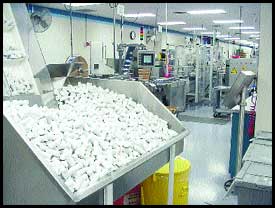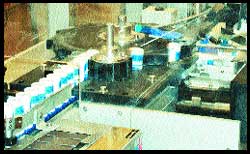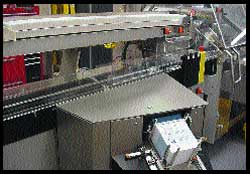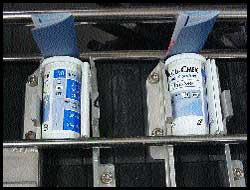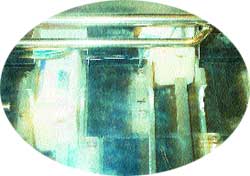January 29, 2014
Doctors and packaging engineers have something in common: Both diagnose ailments for complex systems–the human body and packaging lines, respectively–and prescribe remedies. At Roche Diagnostics in Indianapolis, IN, a continuous-motion cartoning line became the remedy for an outdated packaging line. The new line packages single- and double-vial cartons of test strips used by diabetics to measure blood-sugar levels.
Two integral components of the cartoning line at Roche are an IWK Cartopac SC 4 cartoning machine and two vision systems provided by Systech Solutions. The Systech Tips Advisor™ system is used for the cartoner,
|
Above, unlabeled vials wait to be transported to an unscrambler, where they are orientated to a single-track conveyor. |
while its Tips Sentri™ system is used upstream in the vial-labeling area. The Tips Sentri system detects mislabeling with two cameras, and the Tips Advisor system operates five cameras for the cartoning machine.
Roche decided to install a new cartoning line after product volumes proved to be too much for its 100-carton/min operation. The new line has been operating since spring 2001, and the cartoning machine is capable of running at line speeds of up to 250 cartons/min. With the new speed, Roche decided an enhanced vision system was needed. Doug Lewis, project leader for diabetes care, says, "One of the side benefits of building a new packaging line was the opportunity for additional inspection [vision system] for the line." Other detection devices include sensors for product orientation, conveying and labeling.
Carton's components
The intricate nature of medical diagnosis is similar to identifying how to carton multi-components for a healthy packaging line. The cartoning challenge is to insert a vial, a code key and two pieces of product literature, both folded, into a 17/8x31/4-in. SBS paperboard carton. During PD's visit, Roche was cartoning single-vial cartons for the Far East market.
Each high-density polyethylene vial of test strips–containing 10, 25 or 50 strips–is given a lot number that corresponds to a code key. The code key provides a calibrated code for the strips, which are inserted into a diagnostic meter, and is slightly bigger than a computer chip with an encasement. The code key and test strips need to match the lot number (production reference), otherwise the blood glucose results can be inaccurate.
The other ingredients that are inserted into the cartons are two literature pieces. A prefolded, approximately 13/8 x 27/8-in. piece informs users about guidelines in six different languages, and a sheet-fed literature piece is 61/2 x 81/2 in. The sheet-fed information, also known as the "vialator," is folded four times by a GUK-model CARTONAC and is reduced to a size of 61/2 x 11/8 in. when folded. The vialator literature displays visual information on how to use the strips, and provides pictures that illustrate how to insert the strip and code key into the diagnostic meter, and how to apply blood to the test strips.
The desiccated test strips are packaged into vials in a humidity- and temperature-controlled environment before entering the packaging area. The 15/8 x 11/2-in. HDPE vials are filled with test strips when they enter the 7,000-sq-ft carton packaging area.
In the packaging area, operators load the sealed vials into a Hoppmann hopper, and an incline conveyor transfers the vials over the product conveyor line to an Omega unscrambler. The elevated unscrambler feeds the vials one at a time down a track to a turntable. The turntable captures the vial, and a sensor assembly determines whether the vial is cap-up or cap-down. The vial is orientated on the turntable and is rotated if it is cap-up, since the product needs to be cap-down to move to the product conveyor.
|
Above, labels are applied after they pass the second vision system camera, which inspects them for the number of strips, expiration date, lot number, control values and calibration code. |
The cap-down, blank vial proceeds to a single-track product conveyor that allows for consistent spacing between products. From there, the vials travel through a Thermedics TDX detection system from Thermo Detection that looks for damaged, sealed caps. Desiccant beads reside in the vial's cap and are sealed off with a circular paperboard liner. If the liner is damaged, the desiccant beads can escape from the cap.
The cartoning line at Roche is not the "Information Superhighway" but it does output vital information at line speed for the labels. The vials' labels display information concerning the number of strips, expiration date, lot number and control values, and a calibration code that corresponds to the code key for the diagnostic instrument.
At line speed, blank labels are printed separately and merge with the single-track product conveyor carrying the vials. A Weiler labeling machine with a Lasetec laser scribes the product-specific information onto Keller Crescent and Topflight Corp. pressure-sensitive adhesive labels. The first Sentri vision system's camera inspects the 2D matrix code on the label, and the second camera examines the number of strips, expiration date, lot number, control values and calibration code on the labels. The printed labels move towards the single-track conveyor and are applied to the passing vials.
Cartoning machine
From an accumulator, the conveyor leads the cap-down vials into the cartoning machine, which integrates a vial, a code key and prefolded literature into a product bucket.
The T-shaped, product bucket is a horizontal compartment that is approximately, 3x3-in. The vial enters the product bucket first and is used as the central component to pack around. A starwheel tips the vial from an upright, cap-down position to a horizontal one and loads it into the product bucket.
The prefolded literature and code keys present the first hurdle for the cartoning process. Adjacent to the cartoning machine, a Hoppmann unscrambler connects to a conveyor that transfers the code keys to a 45-degree, angled rotating starwheel, located next to the product conveyor line.
The starwheel places the code key into the individual product bucket, positioning it right above the vial's lid. The first camera of the cartoning vision system is located on the rotating starwheel, inspecting the code key.
|
Above, vials move vertically to the starwheel and are tipped horizontally into the product bucket. |
On the opposite side of the cartoner resides a Hoppmann storage hopper holding prefolded leaflets, measuring approximately 13/8 x 27/8 in. The vision system's second camera records the matrix code information on the literature. From the Hoppmann centrifugal sorter, the leaflets are delivered on an overhead conveyor belt to a product magazine. Roche uses a GUK Model PA 21 leaflet dispenser to place the prefolded material into the product bucket. An oscillating "arm" takes a literature piece from the magazine and drops the piece into the product bucket. The vertically placed literature lies between the vial and the leading wall of the product bucket.
The code key and prefolded literature surround the vial in the product bucket, but one last piece to the puzzle must be included for a finished carton. A four-folded literature piece, the vialator, is that last ingredient. The literature, when folded, will wrap around the vial in a "U" shape, which is why it is called the vialator.
When folded, the vialator is 61/2 x 11/8 in., and with that smaller length, it is able to fit over the vial's cap and body, as well as the code key in the product bucket. Another vision system camera is located at the folder to inspect the matrix code for the vialator.
The vialator is folded and transferred underneath the product conveyor to a literature clip. The literature clip is located on the product bucket that holds the other three components. At this point, the four components are placed together to fill the product compartment.
Cartoner: two chains
The cartoner's design utilizes two chains–a product chain and carton chain–that run parallel to each other. The product chain's four components are eventually "pushed" horizontally into individual, open paperboard cartons residing in the carton chain. Opened cartons are fed into the carton chain via an upper-level conveyor track. The upper-level conveyor contains flat cartons traveling downstream to a horizontal carton magazine. The magazine receives the cartons from the conveyor and waits for a rotating suction arm to pick individual containers.
The cartons are transferred to stationary, opposing vacuum cups for positive opening. A second rotating arm takes the opened containers and delivers them to the carton track. A vision system camera is located in this carton transfer area to inspect for the carton's matrix code.
With the four components positioned in the product bucket and traveling in the product chain, product pushers drive the bucket's materials forward into the carton's train. At this point, the carton's train is running directly behind the product train, and the vial, the code key and the prefolded and vialator literature are pushed into the carton. The product pusher–a plastic bumper–slides the bucket's components approximately 4 in.
horizontally into the bottom end of the opened carton. The components fit snugly in the carton and do not move once they are placed there. From there, the cartoner switches to a one-track conveyor.
|
|
The folder attached to the product conveyor prepares the "vialator" literature to be transferred underneath the conveyor to the product bucket, above top. The vialator, above, is placed in the bucket via the literature clip and is pushed eventually into the carton. Below, the continuous-motion product pushers slide the material into the bottom of the opened paperboard cartons. |
|
While the carton's flaps are open, a Sator laser system applies two lines of text on the outer closing flaps. The text includes the expiration date and lot number, and is scanned by an Optical Character Verification camera. The OCV is the fifth and last camera in the cartoner's vision system.
After the camera inspects the carton's flaps, fixed guide rails on the single track prepare the carton for the hot-melt applicator. The guide rails force the flaps inward but not all the way closed. A Nordson 3400 Hotmelt System applies glue on both carton ends, and then the carton moves to the sealing station. Another option available for carton sealing is a tuck-in closure.
This stage of the cartoner contains two reject stations. The first station collects upstream information from the vision system's cameras and sends it to the programmable controller in real-time. The reject station is activated when a carton is inaccurate. After the first reject station, a Garvens checkweigher weighs the carton and its contents. A second reject station immediately follows the checkweigher and removes cartons under the proper weight. From there, the single-track conveyor carries the cartons to a Pester overwrapper, where the single-vial cartons are wrapped in packs of 10. The bundled 10-carton packs are manually placed into corrugated trays and put onto pallets.
Speed has always been a huge factor for packaging operations, and Roche's Doug Lewis recognized the opportunity to increase volume with this new line. Lewis remarks, "We looked at several equipment manufacturers, and the IWK machine stood out. We looked at reliability, cost and equipment design, and how that related to our unique process. Several companies can build cartoners, but we needed a machine that was well-designed to integrate our many components."
With Roche's continuous-motion cartoning machine producing 250 cartons/min, the doctor will not be making house calls to this packaging line.
More information is available:
Cartoning machine: IWK Packaging Machinery, Inc., 973/227-5575. Circle No. 236.
Bulk hopper, unscrambler: Omega Design Corp., 610/363-6555. Circle No. 237.
Detection system: Thermo Detection, a div. of Thermo Electron Corp., 978/251-2191. Circle No. 238.
Labeler: Weiler Labeling Systems, 609/273-3377. Circle No. 239.
Labels: Keller Crescent Co., 317/328-7355. Circle No. 240.
Labels: Topflight Corp., 800/233-9386. Circle No. 241.
Vision systems: Systech Solutions, Inc., 800/847-7123. Circle No. 242.
Bulk hopper and unscrambler: Hoppmann Corp., 800/368-3582. Circle No. 243.
Leaflet dispenser, folder: GUK-Falzmaschine GmbH and Co. KG, 49 7426 703 1. Circle No. 244.
Glue applicators: Nordson Corp., 800/683-2314. Circle No. 245.
Checkweigher: Mettler-Toledo, Inc., 800/786-0041. Circle No. 246.
Overwrapper: Pester USA, 201/327-7009. Circle No. 247.
About the Author(s)
You May Also Like
